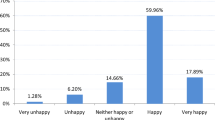Abstract
There are two tendencies in the literatureregarding the relationship between income andsubjective well-being. The first tendencymaintains that there is a strong relationshipbetween these two variables, and that thepoorer the population, the more pronounced thisrelationship. The second tendency downplaysthis relationship, arguing that a largepercentage of happiness cannot be explained byeconomic variables. The objective of this studywas to compare the subjective well-being ofthree socioeconomic groups – extremely poor,moderately poor and not poor – and to discoverthe combination of subjective well-beingfactors that makes it possible to predict thesocioeconomic group to which subjects belong.Subjective well-being was measured by using aninstrument developed by Palomar Lever (2000) andconsisting of eleven related factors thatinquire into the subjects' satisfaction ineleven areas of life. The results indicatestatistically significant differences in nearlyall the subjective well-being factors inrelation to the socioeconomic group to whichsubjects belong, with the poorest subjectsreporting the least satisfaction. In additionsome differences were found in relation to sexand age. Also, low correlations were observedbetween income and subjective well-being in theextremely poor and moderately poor groups, withmore of these correlations in the first group,followed by the last. Finally, it was foundthat membership in the socioeconomic groups canbe predicted by a combination of subjectivewell-being factors such as satisfaction withone's recreational activities, socialsurroundings, personal development and couplerelationship.
Similar content being viewed by others
REFERENCES
Allardt, E: 1976, ‘Dimensions of welfare in the comparative Scandinavian study', Acta Sociológica 19, pp. 227-239.
Andrews, F.M. and S.B Withey: 1976, Social Indicators of Well-being: Americans' Perceptions of Life Quality (Plenum Press, Nueva York).
Belle, D: 1990, ‘Poverty and women's mental health', American Psychologist 54, pp. 821-827.
Benedikt, M: 1999, Values (The University of Texas Press, Austin).
Biswas-Diener, R. and E. Diener: 2001, ‘Making the best of a bad situation: Satisfaction in the slums of Calcutta', Social Indicators Research 55, pp. 329-352.
Brickman, P., D. Coates and R. Janoff-Bulman: 1978, ‘Lottery winners and accident victims: Is happiness relative?’ Journal of Personality and Social Psychology 36, pp. 917-927.
Bryant, F.B. and J. Veroff: 1982, ‘Attitudes and social cognition. The structure of psychological well-being: A sociohistorical analysis', Journal of Personality and Social Psychology 43(4), pp. 653-673.
CEPAL-INEGI: 1993, ‘Magnitud y Evolución de la Pobreza en México, 1984–1992. Informe Metodológico', Instituto Nacional de Estadística, Geografía e Informática (INEGI).
CONAPO: 2001, ‘Indices de Marginación. Colección: Indices Sociodemográficos', Consejo Nacional de Población, Mexico City.
Crawford, D., E. Jackson and G. Godbey: 1991, ‘A hierarchical model of leisure constraints', Leisure Sciences 13, pp. 309-320.
Csikszentmilhalyi, M.: 1999, ‘If we are so rich, why aren't we happy?', American Psychologist 54(10), pp. 821-827.
Diener, E. and R. Biswas-Diener: 2001, ‘Will money increase subjective well-being?', Social Indicators Research 00, pp. 1-51.
Diener, E., L. Seidlitz Sandvik and M. Diener: 1993, ‘The relationship between income and subjective well-being: Relative or absolute?', Social Indicators Research 28, pp. 195-223.
Easterlin, R.: 2001, ‘Income and happiness: Toward a unified theory', The Economic Journal 111, pp. 465-484.
Fuentes, N.: 2001, ‘Economic theory and subjective well-being: Mexico', Social Indicators Research 53(3), pp. 289-314.
Furnham, A. and M. Arglyle: 1998, The Psychology of Money (Routledge, London).
Godbey, R.: 1986, ‘Non-use of public leisure services: A model', Journal of Park and Recreation Administration 3, pp. 1-12.
Headey, B: 1981, ‘The quality of life in Australia', Social Indicators Research 9, pp. 155-182.
Howard, D. and J. Crompton: 1984, ‘Who are the consumers of public park and recreation services? An analysis of the users and non-users of three municipal leisure service organizations', Journal of Park and Recreation Administration 2(3), pp. 33-48.
Leñero, L: 1994, ‘Las Familias de la Ciudad de México', Sistema Nacional para el Desarrollo Integral de la Familia (DIF) in Mexico, United Nations Children's Fund (UNICEF), Centro Mexicano para la Filantropía (CEMEFI), Instituto Mexicano de Estudios Sociales, A.C.
Mayer, S.E.: 1997, What Money Can't Buy: Family Income and Children's Life Chances (Harvard University Press, Cambridge).
McLoyd, V.C.: 1998, ‘Socioeconomic disadvantage and child adjustment', American Psychologist 53, pp. 184-204.
Ortega: 1993, ‘Mapa Mercadológico de la Mega Ciudad de México. Buró de Investigación de Mercados, S.A. de C.V', Mexico.
Palomar Lever, J.: 1999, ‘Relación entre el Funcionamiento Familiar y la Calidad de Vida en Familias Alcohólicas', Salud Mental. 22(6), pp. 13-21.
Palomar Lever, J: 2000, ‘The development of an instrument to measure quality of life in Mexico city', Social Indicators Research 50, pp. 187-208.
Raymore, L.A., G.C. Godbey and D.W. Crawford: 1994, ‘Self-esteem, gender, and socioeconomic status: Their relation to perceptions of constraint among adolescents', Journal of Leisure Research 26, pp. 99-118.
Ribeiro, M.: 1994, ‘Trabajo Femenino y Vida Familiar. Estudio comparativo entre Quebec y México', Memoria del 1er. Encuentro Nacional de Investigadores sobre Familia, 1, pp. 127-158, Centro Universitario de Estudios sobre la Familia, Universidad Autónoma de Tlaxcala.
Riquer, F. and Pantoja, J: 1998, ‘Mujer, Género y Pobreza: Estado de la discusión en los noventa' en Los Rostros de la Pobreza', 2, 201-249, México.
SEDESOL: 2002, ‘Medición de la Pobreza. Variantes Metodológicas y Estimación Preliminar', Documentos de Investigación. Secretaría de Desarrollo Social, Mexico City.
Veenhoven, R: 1988, ‘The utility of happiness', Social Indicators Research 20, pp. 334-354.
Veenhoven, R: 1991, ‘Is happiness relative?’ Social Indicators Research 24, pp. 1-34.
Wilkinson, R.G.: 1996, Unhealthy Societies: The Afflictions of Inequality (Routledge, London).
Author information
Authors and Affiliations
Rights and permissions
About this article
Cite this article
Lever, J.P. Poverty and Subjective Well-being in Mexico. Social Indicators Research 68, 1–33 (2004). https://doi.org/10.1023/B:SOCI.0000025567.04153.46
Issue Date:
DOI: https://doi.org/10.1023/B:SOCI.0000025567.04153.46




